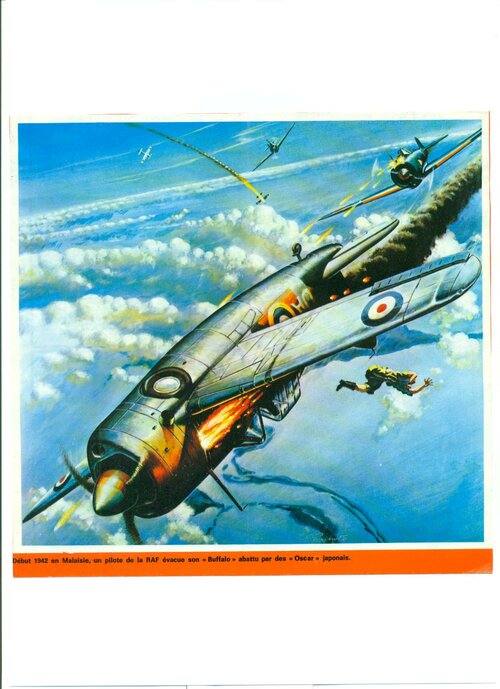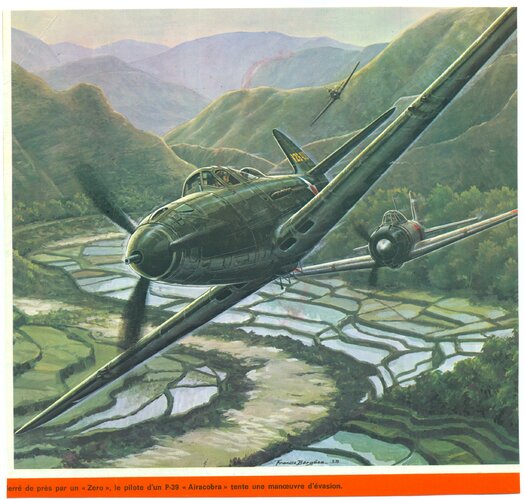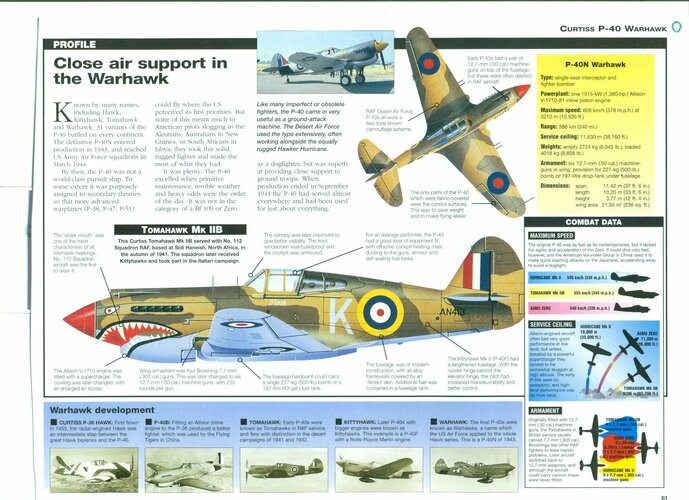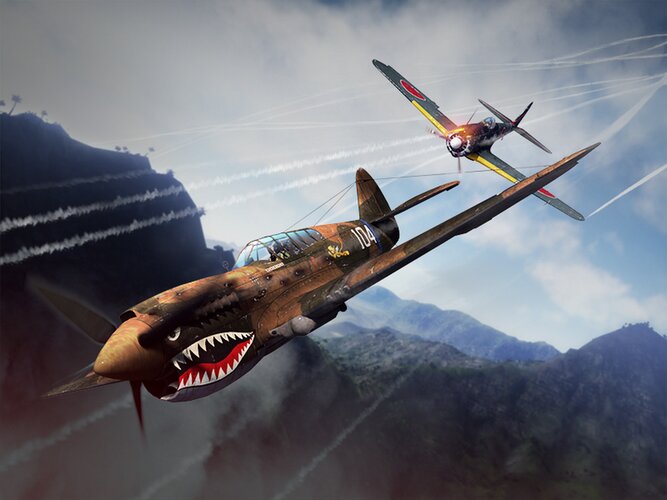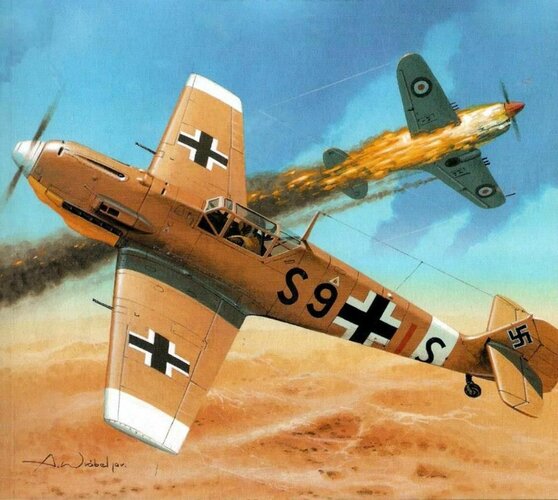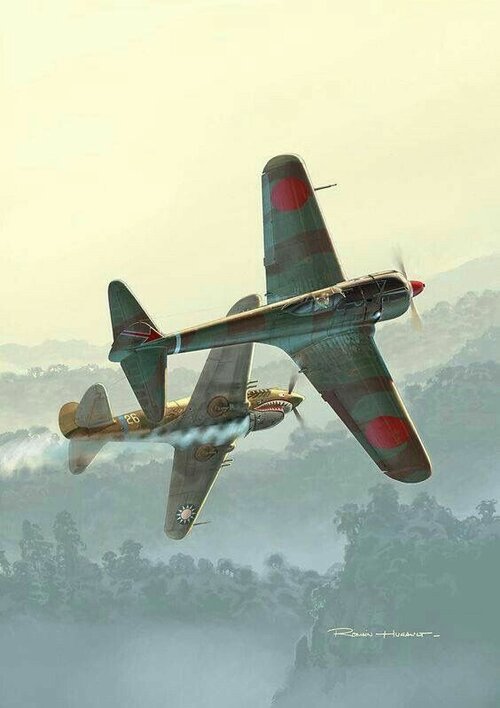Hi everybody,
I often read that Curtiss-Wright Aviation did not do enough research work during the Second World War to be able to survive its aeronautical branch and face the new markets after the Second World War. It is considered that its production and improvement work on the P-40 (we can add the Helldiver) would have absorbed budget and engineers to the detriment of the future.
Now, when I compare, for example, the production of research/new vehicles by Curtiss and, for example, North American (one of the companies, and maybe the company, which was most successful after the war [Fury, Sabre, Super Sabre] and which also had a massive production of an aircraft, the P-51, during the war [two, if we count the B-25]), I see that, between 1940 and 1945, North American flew only three new types of aircraft, including two derivatives of the P-51 (A-36 and F-82) [The 3rd being the failure XB-28], while Curtiss flew 11 new types of aircraft (including XP-46, P-60, XP-55 canard, XP -62, XF-14C and XF-15C with mixed propulsion).
So what was Curtiss' mistake and what should it have done to avoid being overtaken by the competition?
The United States did not feel threatened by European tensions and devoted its resources to the construction of modern commercial aircraft powered by air-cooled radial engines, a type of power plant considered safer and easier to maintain in the world of civil aviation.
The poor production of American military airplanes did not justify the development of special engines and the latest generation of U.S. biplane fighters: Boeing F4B, Boeing P-12, Curtiss F11C and Grumman F3F was powered by Wright and Pratt & Whitney radial engines.
The same was the case with the first generation of American monoplane fighters: Boeing P-26, Brewster F-2A, Curtiss P-36 and Seversky P-35. None of them exceeded 320 mph or 34,000 ft ceiling at a time when the Messerschmitt Bf 109 E-3 and Supermarine
Spitfire Mk.II were fighting 37,200 ft over London, flying at 354 mph.
Curtiss tried to modernize the P-36 by installing an Allison V-12 liquid-cooled engine, but at the time when the P-40
Tomahawk Mk.I entering production, lacking armoured plates and armoured glass protection for the pilot and self-sealing fuel tanks, it was already largely obsolescent by European standards.
The new Curtiss XP-46, with inward-retracting landing gear, automatic leading-edge slots and integral armour, was designed to be the answer for these deficiencies, but their performance fell short of expectations because the underpowered Allison V-1710-39 and the increase of weight.
The Second World War provided a great business opportunity for the U.S. industry when the European countries encountered many difficulties to set supplies of fighters in the international market.
Curtiss was saturated by the enormous orders of H.75 (P-36) and H.81 (P-40) fighters made by French and British.
Then the demand of second-line fighters went to Curtiss-Wright, Seversky, Vultee and North American which achieved great commercial success with the exports of the CW-21, NA-68, P-43, P-64 and P-66 models.
In 1937, Curtiss and Bell proposed the installation of one General Electric exhaust-driven turbo-supercharger to improve the high-altitude performance of the Allison V-1710 engine.
Curtiss build the XP-37 prototype to test the new propulsion system, but the airplane suffered frequent malfunction of the G.E. B-1 turbo-supercharger, resulting in low performance.
The H75 inadequate performance at high altitude was a constant source of concern for the Curtiss Airplane Division staff.
In 1938 one H75 A-1 was modified as the H75 R high-altitude prototype, powered by one R-1830-SC2-G radial engine driving two centrifugal turbochargers, with ventral intercooler. During flight tests conducted in January 1939 the H75R reached a top speed of 330 mph flying at 15,000 ft. The USAAC considered insufficient the increase of performance and the H75 R unsuitable for operational service, due the complexity of the new propulsion system.
Curtiss continuing to perfect the concept, in 1943 the NX 28990 airframe of a H81A was powered by one R-1830-SSC7-G radial engine driving two centrifugal compressors housed in a new streamlined cowling. During flight tests conducted between July and October 1943, the high-altitude prototype reached a top speed of 389 mph and 25,000 ft of ceiling.
On 1 December 1943 the first North American P-51B
Mustang, with 440 mph top speed and 42,000 ft ceiling, was delivered to the USAAF and the Curtiss prototype development was discontinued.
In USA the NACA published a report at the beginning of 1939 about the methods to improve the volume of cooling air flowing over radial engines. In February 1939, Seversky performed the first flight tests with the NX2597 AP-4
Lancer prototype, equipped with ducted and non-ducted large propeller spinners. In March, Curtiss decided to experiment with the new technology transforming the P-36A s/n 38-004 into the XP-42 prototype by adding a large propeller spinner and extension shaft and one air intake placed under the R-1830-31 engine, the prototype suffered serious problems of vibrations.
As a result of all this research, however, there was not any significant aerodynamic achievement. The Curtiss XP-42, the Vultee 48, the Kawasaki Ki.45-03 and the Seversky
Lancer all encountered insurmountable cooling problems and had to be refitted with conventional cowlings. The A-17 A was turned back to its original configuration and back to operations.
At the time when the Curtiss P-36A entering service, the U.S. fighter was already largely obsolescent by European standards.
In February 1937 the USAAC contracted with Curtiss the installation of one advanced Allison V-1710-11 turbo-supercharged V-12 engine in the H75 B airframe. To make room for the experimental B-1 exhaust-driven turbo-supercharger, including the compressor, the Prestone intercooler and heavy tubing system, the cockpit was pushed very far to the rear, resulting in poor visibility during take offs and landings.
The extensively modified prototype, redesigned XP-37, was flown on April 1937 reaching 340 mph at 20,000 ft, but suffered frequent turbo-supercharger malfunction and tail plane flutter, the performance fell short of expectations.
On 11 December 1937 the USAAC ordered thirteen service test airplanes under the designation YP-37. These pre-production machines were fitted with elongated fuselages and Allison V-1710-21 engines with improved G.E. B-2 turbo-superchargers.
The first YP-37 flew on June 1939.
Although the new turbo-supercharger was quite troublesome, the YP-37 remained in experimental service until 1942.
The development of the P-37 high-altitude interceptor was discontinued in favour of a less complex conversion of the P-36 for the Allison engine.
In July, Curtiss got USAAC permission to install in the P-36A s/n 38-10 one V-1710-19 engine, with single-stage, single-speed engine driven supercharger.
The project had the designation Model 75 P (XP-40).
The prototype XP-40 was first flown on 14 October 1938, only two weeks after the settlement of the Munich crisis. Because of this heritage the plane was relatively easy to produce in large numbers and a total of 13,739 Curtiss P-40 were built.
The V-1710-19 engine proved to be more reliable than the turbo-supercharged V-1710-21, although its performance falling off at higher altitudes up to 32,750 ft.
Despite their lack of power at altitude the Curtiss P-40 was the best U.S. fighter available in large quantities early the Second World War, during 1941 Curtiss expanded its manufacturing area by 400 per cent, with sixty aircraft a day at the peak of wartime production.
When the ex-French fighters Curtiss H81 A-1 were delivered to Britain, in September 1940, the model was already obsolete by European standards. The RAF concluded that these airplanes, supplied without armour or self-sealing fuel tanks, were unsuitable for combat and were used only for training roles under the designation
Tomahawk I.
In November 1940 the BK853 airframe was tested at Boscombe Down establishment and satisfactory operations in the tropics was predicted following cooling trial. The second batch of ex-French fighters Curtiss H81 A-2
Tomahawk II was shipped overseas.
In July 1941 the
Tomahawk IIA (equivalent to the P-40 B) fitted with British TR-9D radio, armour and self-sealing tanks externally-covered with
Linotex, was supplied to the Nº 112 Sqn. of the
Desert Air Force.
In the Mediterranean front the
Tomahawk IIA performed well against the Fiat C.R. 42 and G.50 bis fighters of the
Regia Aeronautica, but it was surpassed in top speed, climb rate and ceiling by the Messerschmitt Bf 109 E-7/trop and F-2/trop fighters of the German JG27.
When the Axis-generated wave of destruction stopped at Midway and El Alamein, the Allied could only count on the Supermarine
Spitfire Mk.V, Curtiss
Warhawk, Grumman
Wildcat and Lockheed
Lightning modern fighters.
The P-40 D (
Kittyhawk Mk.IA) was extensively redesigned to improve performance with V-1710-39 engine and 6x0.50 cal wing mounted machine guns. The new model was delivered to the Western Desert Air Force in September 1941 and performed well against the Macchi M.C. 200 Italian fighter, but was displaced to the ground-attack role by the more capable M.C. 202 and Bf 109 F-4/trop fighters.
When looking for ways to improve the altitude performance of the
Kittyhawk, Curtiss decided to use the 1,300 hp Rolls-Royce/Packard V-1650-1 engine, the
Merlin did much to overcome the limitations imposed by the Allison. In order to adjust to the additional torque during low-speed landings and high-speed dives the airplane was fitted with a dorsal fin but without success.
As a result of installing an in-line engine in the P-36 airframe, the P-40 experienced lateral control problems and much effort was expended to improve their longitudinal stability during its development.
Early 1942 one P-40 F-1 was modified as the YP-40 F prototype (41-13600) with a fuselage lengthened 20 inches and a large vertical tailfin.
The solution was sufficient and Curtiss started the production of the P-40 F-5 (
Kittyhawk Mk.IIA) with the fuselage lengthened by pushing the tailfin back without altering the tail plane.
Most air combat in the Mediterranean Front took place below 16,000 ft. At low altitude the Bf 109 F-4/Trop was superseded by the P-40 F-5 in horizontal manoeuvres and dive speed, but the German pilots used high-altitude sweeps followed by 'dive-and-climb' tactics to avoid dogfighting.
On November 1942 began operating in Tunisia the new Focke-Wulf Fw 190 A-3 that surpassed all the Allied fighters flying at medium and low altitudes.
From 26 May 1942 the
Kittyhawk operated primarily as fighter-bomber role, fitted with underwing bomb racks, under the cover of the
Spitfire Mk.V.
Although the P-40 F was superior to the Allison powered series, their top speed was 66 mph inferior to the 430 mph of the North American P-51B
Mustang.
In an attempt to streamline the radiator air intake, Curtiss used the P-40 F-1-CU s/n 41-13602 (with short fuselage) under the designation YP-40 F, for experimental tests of a revised cooling system, with the radiator mounted aft enclosed in a
Mustang-style ventral fairing. Early flight trials were disappointing and these modifications did not result in series production.
The P-40 never excelled in its high-altitude performance due the excessive weight of its strong structure, included a five-spar wing.
During the development of the airplane, the gross weight increases with each new version, the addition of bullet proof windshields, pilot armour, self-sealing fuel tanks, droppable fuel tanks and bomb racks decreasing the P-40 performance.
On June 1941 the gross weight of the Messerschmitt Bf 109 F-4/trop was 5,260 lbs, the Macchi M.C. 202 weighted 6,636 lbs and the P-40 F-5 9,350 lbs.
The service ceiling of the M.C. 202 was 37,730 ft, the Bf 109 F-4/trop reaching 38,058 ft and the P-40 F-5 34,000 ft only.
Early in 1943 Curtiss introduced weight-saving measures in the P-40 L, the fuel amount was reduced and two of their machine guns were removed to save 250 lbs, but the increase in performance not correspond to the effort.
The Curtiss P-60 A was to have replaced the P-40 L on the production line, but delays in the development of the new model caused USAAF to order the mass production of 7,220 cheap fighters of the K, M and N series. It low cost kept the P-40 in production until the end of 1944.
When the supply of P-40 F and P-40 L airframes exceeded the availability of
Merlin engines, the last series were built with Allison power plants. The P-40 K was powered by one V-1710-73 rated at 1,325 hp, the P-40 M with one 1,200 hp V-1710-81 and the P-40 N with one 1,360 hp V-1710-88 engine.
The K, M and N series were used as low-altitude fighters and ground-attack planes in Italy, Soviet Union and South-West Pacific.
The main concern of the ground attack pilots was the German ‘hit-and-run’ tactics and the low rearward view of the P-40 was partially improved in the P-40 N series with the modification of the canopy. In 1944 the P-40 N-25 s/n 43-24571 was modified, as the XP-40 N prototype, with a cut-down rear fuselage, a new windshield and a full-view teardrop canopy.
Another attempt to reduce drag was the installation in the prototype XP-40 K-10-CU s/n 42-10219 of two radiators located in the thickened centre section of the wing. The airplane was powered by one V-1650-1
Merlin engine, with two-stage supercharger.
Curtiss attempted several programmes to increase the performance of the P-40, but all failed in the end.
Early 1943 the P-40 K-10-CU s/n 42-9987 was modified as the XP-40 Q-1, a higher performance version with several aerodynamic refinements and much improved cowl lines, but retaining the partially exposed, rear-folding, landing gear.
The power was increased with the installation of one 1,325 hp Allison V-1710-101 engine, with two-stage supercharger, driving a four-bladed propeller. Two semi-flush low-drag radiators and one oil cooler were enclosed in the central section of the wing. The airplane was flown on 13 June 1943.
By November the prototype had been modified, as XP-40 Q-2, the rear fuselage was cut down and a teardrop canopy, with curved windshield, was installed. The oil cooler and the engine air scoop were moved to the chin position and the two radiators were repositioned in the wings.
The USAAF Air Materiel Command recommended that two additional prototypes be constructed.
In January 1944 the XP-40 Q-2 had its wingtips clipped and one Allison V-1710-121 engine rated at 1,425 hp (1,800 hp with water injection) was installed.
The P-40 K-1 s/n 42-45722 was modified as the XP-40 Q-2A prototype, with more streamlined canopy and flat windshield. The aircraft was flown end of March 1944 and the trials revealed similar performance to those of the XP-40 Q-2.
In April 1944 made its first flight the XP-40 Q-3 (ex-P-40 N-25-CU s/n 43-24571) with modifications and performance similar to those of the XP-40 Q-2.
The aircraft had a smaller canopy with longer windscreen and suffered several engine failures.
Even with these modifications the XP-40 Q was still inferior to the contemporary production North American P-51 fighter and the proposed production version P-40 Q, with six 0.50 cal machine guns or four 20 mm M3 cannons, never built.
On April 1940, in response of the USAAC R-40C specification, Curtiss proposed the Model H-88, a 111 per cent homothetic enlarged version of the YP-40F, with laminar-flow wings, powered by one 1,600 hp Continental XIV-1430-3 engine.
On 1 October 1940 the USAAC ordered the prototype (41-140), under the designation XP-53 and six weeks after the contract signature the Army ordered a second prototype (41-19508), Model 90, under the designation XP-60.
On November 1941 the XP-53 was cancelled because of the excessive delays in the availability of the Continental engine. The prototype never flew and was converted into a static test airframe in support of the XP-60 programme.
The XP-53 was the second attempt to produce a successor of the P-40, after the cancellation of the ‘European-style fighter’ XP-46.
The XP-60 prototype (41-19508) was flown on 18 September 1941. The airplane was fitted with a new inward-retracting landing gear, self-sealing tanks, armoured windshield and six 0.50 cal wing mounted machine guns and powered by one 1,300 hp Packard V-1650-1 (
Merlin 28) engine.
During the flight tests it was necessary to increase the surface of the tailfin and the designation was changed to Model 90A.
In August 1942 the prototype was modified with the installation of one 1,350 hp V-1650-3 (
Merlin 61) engine driving a four-bladed propeller, the armament were removed and the designation was changed to XP-60D.
The airplane crashed on 6 May 1943.
Because the V-1650 engine was in demand for production of the North American P-51, the P-60 series underwent many modifications to test different available engines.
The Curtiss Model 95A, designated XP-60A prototype (42-79423) was flown on 1 November 1942 powered by one 1,425 hp Allison V-1710-75, V-12, liquid cooled engine, with turbo-supercharger.
These trials revealed that top speed and climb rate were below that guaranteed by the manufacturer and their development was discontinued.
It was planned to install in the XP-60C (42-79424) prototype one Chrysler XIV-2220-11, liquid-cooled, 16-cylinder, inverted ‘V’ engine, driving a four bladed Curtiss Electric C-542 S-A propeller with 3.96 m of diameter.
This 2,500 hp. experimental power plant, with 122 in length and 2,131 lbs weight, it was too heavy for the XP-60C airframe and was replaced by one Pratt & Whitney R-2800-53 radial engine, with General Electric turbo-supercharger, driving a six-bladed contra-rotating propeller. The first flight were performed on 27 January 1943 and revealed poor performance in comparison to those of P-47 and P-51 fighters.
The XP-60E (42-79425) was identical to the XP-60C, with the exception of the reduction gearing and the four-bladed propeller. The prototype was flown on 26 May 1943 and revealed longitudinal stability problems and inferior performance that the XP-60C.
The YP-60E prototype (43-32763) was a redesigned YP-60A with R-2800-18 engine, four-bladed propeller, cut-down rear fuselage and teardrop canopy.
The aircraft was flown on 15 July 1944, after one more flight tests was transferred to Wright Field for storage and crashed in 1947.
On January 1941, Curtiss started the design MX-88, a high-altitude interceptor with 36,000 ft (11,000 m) ceiling, engine-driven pressurised cabin and heavy armament. The new airplane was powered by one 2,300 hp Wright R-3350-17 radial engine, with turbo-supercharger, driving a six-bladed contra-rotating propeller.
The project was submitted to the USAAC on 29 April 1941, as Model 91 proposal.
On 16 May 1941, a letter contract for two prototypes, XP-62 and XP-62A, was approved.
The early Model 91 was fitted with eight 20 mm cannon or twelve 0.50 cal machine guns and laminar-flow wings with combat flaps, but following the mock-up inspection, on 16 December 1941, the USAAF recommended the reduction of weaponry to only four cannons and the elimination of combat flaps to save weight.
On 27 July 1942 the contract for 100 P-62A fighters was cancelled in favour of the mass production of the P-47 G and the B-29.
The prototype 41-35873 was flown on 21 July 1943, without pressure cabin installation.
In 1944 the airplane was used to investigate new pressurization systems.
The XP-62 was cancelled without the prototype having resumed flight tests.
On 22 June 1940 the USAAC signed a contract for preliminary development of the Curtiss CW-24 and construction of a wind tunnel model, under the designation XP-55.
Such a radical configuration required the construction of the CW-24B, a flying testbed to prove the design viability.
On 21 December 1941 the CW-24B made its first flight, at Muroc Dry Lake test center, powered by a 275 hp Menasco C-6S-5 engine.
Despite the strong security measures, intelligence services of the IJN obtained enough information about the project to believe that it was the successor of the Curtiss P-40 fighter. Early in 1943 Lieutenant Commander Masaoki Tsuruno, of the First Naval Air Technical Arsenal, proposed the construction of the
canard fighter 18-shi-Otsu J7W
Shinden based on the information obtained on the XP-55.
In fact, the definitive Curtiss XP-55 version was not selected by USAAC for production and only three prototypes were built, two of which were destroyed in accidents.
On 10 July 1942 the USAAF ordered three prototypes, the 42-78845 flew on 13 July 1943 powered by one 1,425 Allison V-1710-95, V-12, liquid-cooled engine, with mechanical supercharger, driving a three-bladed (jettisonable) pusher airscrew.
The aircraft was fitted with laminar-flow swept wings angled back 45 degrees and tricycle undercarriage.
USAAF was unimpressed with the 377 mph top speed reached with the Allison engine versus the 507 mph promised with the X-1800 cancelled in October 1940.
The first prototype showed excessive take off run, dangerous stall behaviour, poor longitudinal stability, low-speed handling problems and engine overheating.
On 15 November 1943 the plane was lost, in an inverted spin, when the engine failed.
The second prototype 42-78846 flew on 9 January 1944 suffering from ‘no-warning before stalling’ phenomena. To improve the stall characteristics the nose elevator and the aileron tabs were modified.
The third prototype 42-78847 was flown on 25 April 1944, fitted with wing extensions and modified nose elevator and armed with four 0.50 cal nose mounted machine guns.
On 27 May 1945 the aircraft crashed when the pilot attempted a barrel roll.
Americans were not lucky with the Curtiss XP-55, after four years of flight testing they have not achieved an airplane sufficiently stable to take part in combat operations.
Although it was less sensible to the compressibility buffeting than conventional airplanes, thanks to a NACA 0015 type wing profile, it was also too heavy and slower than the P-47 and P-51 in service.
To replace the F4F
Wildcat, the U.S. Navy issued the 23 February 1941 Specification calling for a new carrier-borne interceptor designed for service aboard the 45,000-ton
Midway-class carriers.
Grumman Aircraft Engineering Corp. proposed an extensively modified
Wildcat powered by one Wright XR-2600-10 radial engine without turbo-supercharger.
It was a design suitable to the needs of the U.S. Navy that was built and used with great success under the designation F6F
Hellcat.
The only way to compete with Grumman was to propose a fighter with superior performance. Curtiss decided to use a turbo-supercharged liquid-cooled in-line engine with the intention of surpassing Grumman's design in top speed and ceiling.
The U.S. Navy preferred to use air-cooled radial engines, but the F6F had been designed to defend the fleet against the attacks of low level torpedo-bombers and medium-altitude dive bombers and the existence of German bombers with 41,000 ft (12,500 m) ceiling could not be ignored.
On 30 June 1941 the U.S. Navy signed a development contract for a new high-altitude interceptor, under the designation XF14 C-1.
The airplane was powered by one 2,300 hp. Lycoming XH-2470-4, 24 cylinder ‘H’, liquid-cooled experimental engine, with turbo-supercharger, driving a six-bladed contra-rotating airscrew.
Early 1944 the U.S. Navy recommended the installation of one 2,300 hp Wright XR-3350-16 turbo-supercharged radial engine in the XF14 prototype (Bu no.03183) and continue its development under the designation XF14 C-2.
The airplane was flown in July 1944 reaching only 398 mph versus the guaranteed 424 mph. The propeller produced an undesirable vibration and the pressurised cockpit was not yet installed.
When Allied intelligence services discovered that the Japanese had serious difficulty building their own turbochargers, the tactical need for a naval high-altitude interceptor had failed to materialise and further development of the XF14 C-2 was cancelled.


